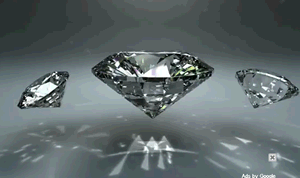Diamond and quartz
Covalent
bonding in all directions.
The strongest form of bonding found in Nature.
Diamond
Diamond is one such substance that has a 3D covalent network lattice. Diamond is composed of carbon atoms each bonded covalently to 4 other carbon atoms in a tetrahedral arrangement. The structure is so strong that diamond has a melting temperature of over 3,550 degrees Celsius. At this temperature the covalent bonds break and the atoms fly off independently at high speeds, the substance is said to sublime( the solid form changes into the gas phase).
Click to view the internal structure of diamond

Diamond and silicon dioxide are very similar in structure. However, the fact that diamond is composed of carbon atoms with pure covalent bonds between them makes it a little harder and stronger than silicon dioxide. Strong, pure covalent bonds between carbon atoms makes diamond chemically resistant. Diamond has no dipoles through which solvent molecules can attach and disrupt the lattice.
Silicon dioxide(beach sand) has polar covalent bonds as the bonding occurs between atoms of different electronegativities. Silicon dioxide can be dissolved slowly by very alkaline solutions and the strength with which the atoms are held in the lattice is evident when we compare its melting temperature(1,770 degrees Celsius) with that of diamond.
Both diamond and silicon dioxide have no free moving charges and therefore can not conduct electricity in the solid state. Both are brittle which can be explained by the directional nature of the electrostatic forces that bond the atoms in the lattice.
![]()
Silicon dioxide
